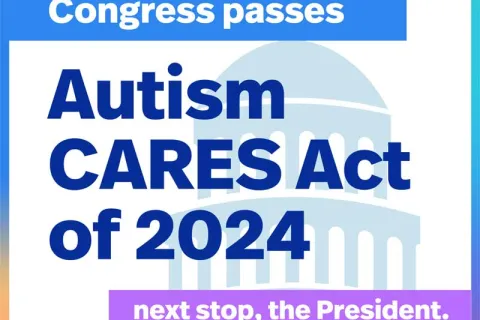Autism and dental anesthesia
Is sedation safe for use at the dentist?
By Elizabeth Shick DDS, MPHDr. Elizabeth Shick is the director of Pipeline Programs and Global Health Outreach at the University of Colorado's School of Dental Medicine. Dr. Shick co-authored the Autism Speaks ATN/AIR-P Tool Kit for Dental Professionals.
The following is a common question, shared by so many people with loved ones who are autistic:
Is sedation safe for a dental visit? Our 25-year-old son has autism, and it’s so upsetting to see him strapped into a jacket for procedures.
Of course dental procedures can be uncomfortable and scary for anyone. This distress is amplified for many children and adults with autism. And I certainly understand that you find it emotionally wrenching to see your son physically restrained – even if it’s for his safety.
Fortunately, we have a broad range of treatment options – including conscious sedation. While generally safe when administered by trained experts, sedation comes with risk. We have all seen stories like the one of the young girl who went into cardiac arrest after an apparent overdose of sedative drugs before a root canal.
Autism and dental anesthesia treatment options
Clearly, risks must be balanced against benefits. It’s also important to know that dentists don’t generally receive training in the use of restraints, sedation or anesthesia during standard dentistry education. So I recommend seeking out a dentist who has completed additional training with a focus on these procedures. Once you have such a dentist whom you trust, I suggest discussing the pros and cons of the following options.
Conventional treatment
With patience and understanding, many children and adults with autism can sit through a normal dental visit without restraints or sedation. In my experience, this involves talking the patient through procedures and using positive reinforcement to accomplish appointment goals.
In the Autism Speaks Tool Kit for Dental Professionals, we discuss helpful techniques such as desensitization, Applied Behavior Analysis and the use of social stories and visual supports. There are no added health risks with these approaches. However treatment may progress slowly and take multiple appointments.
Protective stabilization
Protective stabilization is an important option when the dental patient can’t be persuaded to sit still in the dental chair. This is to ensure safety for both the patient and the dental staff. This can be as simple as having a parent, caregiver or dental assistant hold the patient’s hands. If this isn’t enough, we might use a wrapping device made from soft cloth to help stabilize the patient’s arms and legs.
In our Autism Speaks tool kit for dental professionals, we recommend that dentists get advanced training on how and when to properly and safely apply such restraints. It’s perfectly appropriate for you to ask the staff if they’ve received training in protective stabilization, sometimes called “medical immobilization.”
Many dentists feel most comfortable with medical immobilization because it’s the safest way to perform dental procedures when the patient can’t be depended on to hold still.
Nitrous oxide
Inhaled through a nose mask, nitrous oxide is a generally safe anti-anxiety medicine. Importantly, the patient must continue breathing through the nose until the dental procedure is complete. So it’s not a good option for children younger than four or five or anyone who is crying or otherwise breathing through the mouth. In addition, a small minority of patients simply don’t respond to nitrous oxide. For some, it causes nausea, though this rarely lasts for more than a few hours after the appointment.
Conscious sedation
Conscious sedation involves the use of sedatives to produce a calm, sleepy state without loss of consciousness. Individuals with autism vary widely in how they respond to conscious sedation. And sedatives can have side effects. So it’s important to carefully screen patients to rule out respiratory problems, evaluate tonsil size and look for other medical contraindications. If you and your child’s dentist are considering conscious sedation, I recommend having a physician perform a medical exam prior to the dental visit. You want to ensure that your child is a good candidate.
During conscious sedation, an appropriately trained assistant must carefully and continually monitor the patient’s vital signs at all times. Before dental professionals administer sedation, most states require that they complete advanced training and licensing. So ask about your dentist’s qualifications and credentials.
Usually the sedative is given as a pill or liquid one hour before the procedure. The most common choices include midazolam (Versed), hydroxyzine pamoate (Vistaril), meperidine (Demerol) or chloral hydrate. In addition, the dentist may want to use stabilization restraints and supplemental oxygen during the procedure.
General anesthesia
General anesthesia, which involves loss of consciousness, is a last choice for those who don’t respond to the above options. It must be administered by a dental or medical anesthesiologist or certified registered nurse anesthetist in a hospital or fully equipped healthcare center. General anesthesia brings a number of health risks. So generally it’s not recommended for dental cleanings or other routine dental procedures.
I highly recommend that you and your son’s dentist discuss these treatment options in the context of the procedures your son needs. The Autism Speaks ATN/AIR-P Tool Kit for Dental Professionals can be a particularly helpful guide in this discussion.








